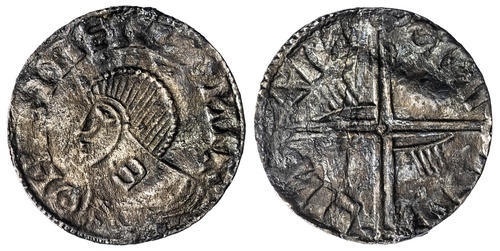
Auction: 25021 - The Simpson Collection of Hiberno-Norse and Irish Coinage
Lot: 13
Hiberno-Norse (c. 1035-1060), Phase II/III Mule, Penny, Dublin, in the style of an Æthelred II Long Cross Penny, stylised legend, draped bust left, rotated E on neck, rev. stylised legend, voided long cross, stylised hands in two opposing quadrants, 0.93g [14.10gns], 4h (SCBI 22 [Copenhagen], 199; L. E. Bruun [1922], 309; cf. SCBI 32 [Ulster Museum], p. 9; Blackburn, BNJ 78/5, pp. 133-134, Fig.7, coin 3; S.6126/6132), trace porosity to otherwise lustrous and field-toned surfaces, of pleasing fabric and well-struck up, a bolder very fine, and OF THE HIGHEST RARITY, perhaps only three other mules known
Provenance
The John Noel Simpson Collection of English, Irish and Hiberno-Norse Coins
With printed collector's ticket
The extreme rarity of Phase II/III mules has been documented by both Wilfred Seaby and Mark Blackburn. In his 2008 BNJ article "Currency under the Vikings. Part 4: The Dublin Coinage c.995-1050," Blackburn suggests these coins are scarce because "old dies were withdrawn and replaced with new ones" during a reform that increased the weight standard from 0.6g to 1.0g. He specifically notes that only Phase II obverse dies marked with the 'E' symbol were muled with Phase III 'hands' type reverses.
Seaby is more specific in identifying the number of known examples, declaring that only three have been traced. He writes: "Although there is no example of the E coins (primarily of Phase II) amongst those in the Belfast Museum having a two-hand reverse of Phase III, there is such a specimen at Copenhagen (K199). That this mule is not unique is confirmed by two further similar coins in private collections, one of which shares the same obverse die as the Bruun piece but has a different reverse die."
Seaby identifies the owners of the other two examples as Mark Blackburn, formerly of the Fitzwilliam Museum, Cambridge, and Mark Denton.
Examination of the Blackburn example, illustrated in his 2008 article, shows it not to be the coin under discussion. Furthermore, comparison with the Bruun coin (SCBI 22 [Copenhagen], 199) reveals that neither the Blackburn piece nor the present specimen shares an obverse die with the Bruun example.
This evidence therefore suggests two possible scenarios. Firstly, the Denton example might be the coin Seaby described as sharing an obverse die with the Bruun piece. However, without analysis of the Denton example this cannot be confirmed. If so, the present specimen would represent a previously unrecorded fourth example.
Alternatively, the other option would suggest Seaby was incorrect about die-sharing between specimens, in which case the present coin could be inferred to be that formerly owned by Denton.
cf. Mark Blackburn, 'Currency under The Vikings. Part 4: The Dublin Coinage c.995-1050' BNJ 78, 5, 2008
cf. Wilfred Seaby, SCBI 32, Ulster Museum, Belfast, Part II, Hiberno-Norse Coins, 1984
Subject to 20% VAT on Buyer’s Premium. For more information please view Terms and Conditions for Buyers.
Sold for
£2,300
Starting price
£500




